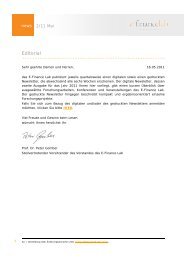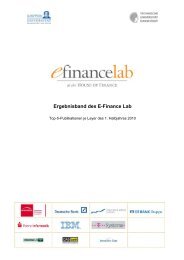Prof. Dr. Wolfgang König, Prof. Dr.-Ing. Ralf ... - E-Finance Lab
Prof. Dr. Wolfgang König, Prof. Dr.-Ing. Ralf ... - E-Finance Lab
Prof. Dr. Wolfgang König, Prof. Dr.-Ing. Ralf ... - E-Finance Lab
You also want an ePaper? Increase the reach of your titles
YUMPU automatically turns print PDFs into web optimized ePapers that Google loves.
Table 1 Overview of the multisourcing portfolio<br />
Organization Area of responsibility Locations involved<br />
ARCHITECT • Definition of architectural framework<br />
• Implementation controls<br />
Two locations in Germany<br />
IMPLEMENT • Functional design Four locations in Spain<br />
• Technical design<br />
• Implementation<br />
One location in Brazil<br />
SCREEN • End-user front-end design One location in Germany<br />
TEST • Software test One location in India<br />
in culturally diverse situations” (Ang and<br />
Inkpen 2008, p. 338), as both the client<br />
and the vendor must negotiate differences<br />
in their values and work practices<br />
and learn how to adapt for the project to<br />
succeed (e.g., Carmel and Agarwal 2001;<br />
Krishna et al. 2004; Levina and Vaast<br />
2008).<br />
In summary, both control mechanisms<br />
as well as interorganizational learning<br />
have been shown to individually contribute<br />
to the mitigation of cultural differences.<br />
However, there remains little<br />
understanding of the interplay of formal<br />
and informal control mechanisms<br />
with interorganizational learning or how<br />
the interaction might contribute to mitigate<br />
cultural differences in global, multisource,<br />
ISD outsourcing projects. Furthermore,<br />
most of the preceding studies<br />
address dyadic client-vendor relationships,<br />
whereas the specific challenges of<br />
multisource projects remain unconsidered.<br />
3 Research Methods<br />
As outlined, we lack sufficient knowledge<br />
about the interplay of control and<br />
learning in global, multisource, IS outsourcing<br />
projects. Therefore, to increase<br />
this understanding, as well as to reveal<br />
the interactive effects on cultural differences,<br />
the present qualitative research<br />
features an in-depth, exploratory, singlecase<br />
study (Stebbins 2001;Yin2003). The<br />
subsequent sections describe the underlying<br />
case (3.1) as well as the procedures<br />
used for data collection (3.2) and analysis<br />
(3.3). A chronology of the overall research<br />
process is presented at the end of<br />
this chapter.<br />
3.1 Case Description<br />
The primary unit of analysis was a global<br />
ISD outsourcing project to reengineer a<br />
Business & Information Systems Engineering<br />
financial institution’s online banking system.<br />
The project was initiated because the<br />
old system’s technology required a high<br />
degree of costly expertise, and its maintenance<br />
was set to expire soon. Thus,<br />
the financial institution (BANK) decided<br />
to migrate its system to a new technology.<br />
To develop this new system, BANK<br />
applied a multisourcing strategy to reduce<br />
the risks of dependence. Therefore,<br />
it included four vendors in the project,<br />
as summarized in Table 1. The project<br />
started in October 2008 and finished<br />
in December 2009, successfully and on<br />
time.<br />
ARCHITECT, a German boutique consulting<br />
firm, designed the architectural<br />
framework of the new online banking<br />
system. IMPLEMENT was a leading international<br />
IT vendor for the financial<br />
services sector and operated and maintained<br />
BANK’s old online banking system.<br />
During the reengineering project,<br />
IMPLEMENT had the responsibility to<br />
create the functional and technical design<br />
documents and implement the new<br />
online banking system. To provide these<br />
services at the required quality and cost<br />
levels, IMPLEMENT chose a global delivery<br />
model that involved four locations<br />
in Spain and a captive center in Brazil.<br />
Another vendor, SCREEN, specialized in<br />
web development and was based in Germany.<br />
It was responsible for the frontend<br />
screen design. Finally, a large IT vendor<br />
with international operations, TEST<br />
was responsible for the software testing,<br />
conducted in a testing facility in India.<br />
Thus, the project featured both nearshore<br />
and offshore outsourcing.<br />
Thus BANK’s sourcing strategy for this<br />
project featured not only a global context<br />
but also the involvement of multiple<br />
vendors. In addition to national cultural<br />
differences resulting from the geographically<br />
distributed setting, the various organizational<br />
cultures played major roles<br />
in the project. These national and organizational<br />
cultural differences became<br />
BISE – RESEARCH PAPER<br />
especially visible in work-related values<br />
and practices, as the following examples<br />
indicate.<br />
In particular, BANK’s project manager<br />
recognized the differences on the<br />
national level:<br />
There are also cultural aspects influencing<br />
the cooperation. Due to<br />
thetimepressure,werealizedeven<br />
more that our Spanish colleagues<br />
have another understanding of milestones<br />
and time planning. During<br />
the work day, they sometimes spend<br />
two hours for a coffee break; this is<br />
very different from Germany. With<br />
detailed progress tracking, we managed<br />
to at least communicate our<br />
expectations regarding timing and<br />
quality very clearly. This helped a<br />
lot.<br />
His colleague, a sub-project manager,<br />
also cited differences that arose when<br />
working simultaneously with project<br />
teams from Spain and India:<br />
When it comes to communication, it<br />
is important to differentiate whether<br />
you are talking with a Spanish colleague<br />
or with somebody from India.<br />
When talking to an Indian colleague,<br />
you have to specify 100 %<br />
what you expect, then you also get<br />
100 %. When talking to a Spanish<br />
colleague, you have to specify what<br />
you do not want to get what you<br />
want.<br />
Beyond national cultural differences, organizational<br />
cultural differences became<br />
visible in the newly established intervendor<br />
cooperation. All the vendors previously<br />
had been involved in projects<br />
with BANK, but they had not interacted<br />
with one another in a multivendor setting<br />
before. Against this background, different<br />
work practices came to the surface<br />
and challenged the cooperation. For<br />
example, ARCHITECT was represented<br />
by a team of five experienced experts<br />
who followed an onshore delivery model.<br />
IMPLEMENT’s 50-person implementation<br />
team spread across five geographic<br />
locations and possessed various competences<br />
and practice levels. ARCHITECT<br />
thus initially had trouble understanding<br />
the challenges that faced IMPLEMENT’s<br />
large, distributed project team, including<br />
the need to scale the work to a<br />
distributed team of developers in both<br />
Brazil and Spain. A project manager from<br />
ARCHITECT explained:








